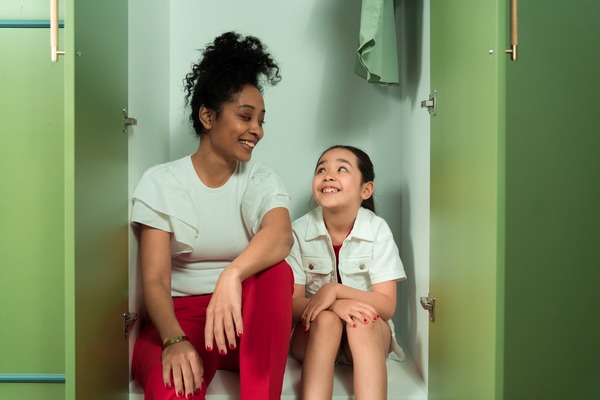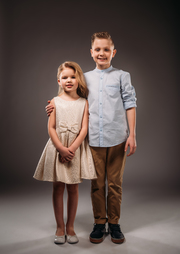How to Encourage Independence in Dressing: 6 Tips for Teaching Kids
In the journey of childhood development, empowering independence is a key milestone that enables children to become confident, capable individuals. Among the various aspects of daily life where independence can be nurtured, dressing is an important and tangible way to encourage self-sufficiency.
Allowing children to take charge of their clothing choices not only cultivates their decision-making skills but also instills a sense of ownership over their appearance. When parents and caregivers offer support and guidance in this area, they play a vital role in the process of creating a space where children can express their originality through clothing.
This guide explores practical strategies and insights to promote independence in dressing, making room for young ones to embrace their own unique style. Ultimately, it helps to build self-confidence from an early age.
1. Introduce a “Choice Time” Routine
Encouraging independence in dressing starts with permitting children to make their own decisions about what they are going to wear each day. A great way to start is to introduce a “Choice Time” routine that allows them to select their clothes each morning. While offering choices within a designated selection, parents can also guide children in understanding weather-appropriate attire. This promotes a balance between freedom and practicality.
Through this daily ritual, children gain a sense of autonomy and responsibility. They learn to develop their style preferences and how it expresses individuality. As they become more sure in their choices, what is often thought of as a boring routine becomes a fun and enjoyable aspect of their daily life.
2. Offer Age-Appropriate Wardrobe Options:
Providing age-appropriate wardrobe options is pivotal in supporting a child’s sense of autonomy. Ensure to offer a diverse range of clothes that align with their age, interests, and comfort.
Consider including comfortable girls swimwear for those sunny beach days or poolside adventures. Add a cute sundresses, stylish shorts, and trendy tank tops. This allows young girls the freedom to express their individuality and fully enjoy their outdoor activities with confidence and style. Empower boys to express their distinctive style by providing a diverse range of clothing choices, from comfortable swim trunks and trendy t-shirts to practical shorts and sporty tank tops.
By respecting each child’s preferences and incorporating their own personality into their wardrobe, kids feel more apt to engage in expressing their unique style. Offering age-appropriate wardrobe options also helps children explore various styles and discover what resonates with them. As kids experiment with different combinations, they develop a deeper understanding of their likes and dislikes, encouraging a strong sense of identity from an early age.
3. Be Patient and Allow Extra Time

Supporting independence in dressing requires patience and understanding. Be patient with children as they navigate the learning process, allowing extra time for them to choose and put on their clothes. Instead of rushing, engage in positive interactions and offer gentle guidance when needed. By making way for sufficient time, dressing becomes an unhurried and enjoyable experience, reducing stress for everyone involved while encouraging independence. Recognizing that learning to dress independently is a skill that takes time to evolve, parents can create a relaxed and supportive environment. As children practice dressing on their own, they are more likely to approach dressing as a fun challenge rather than a source of frustration.
4. Praise and Encourage Self-Expression
Celebrate and praise any effort that is made when a child dresses themselves. Acknowledge their choices and self-expression, even if the outfit may not align with typical fashion norms. Encouragement bolsters their confidence and supports a positive self-image. Emphasize that individuality is something to be celebrated. This gives them the proper mindset that dressing is an opportunity for creative expression and personal identity. Visit A Little Lacey Website with your child to explore ideas that celebrate individuality through style.
By validating their selections and providing positive feedback, parents reinforce the notion that everyone’s unique style matters, even that of a little girl or boy. They are each unique and valued for their expression. Affirmation boosts their self-esteem and encourages them to be confident in making future wardrobe decisions.
5. Teach Basic Dressing Skills
We’ve discussed “why” basic dressing skills is vital for growing a child’s confidence. But let’s not forget about the “how”. Demonstrate how to put on and take off clothes, fasten buttons, zip zippers, and tie shoelaces. Offering step-by-step instructions and practicing these skills together helps them gain mastery. Gradually transitioning from assistance to independence reinforces their sense of achievement and capability.
Parents can celebrate each milestone, such as the first time they button their shirt or tie their shoelaces, to motivate children to continue honing their dressing skills. As children become proficient in these basic skills, children feel a sense of accomplishment and pride in their newfound abilities, strengthening their belief in their capability to dress themselves.
6. Nurture a Positive Environment for Self-Confidence
Creating a supportive and positive environment plays a significant role in encouraging independence in dressing. Avoid criticizing or making negative remarks about their outfit preferences. Instead, focus on praising their efforts and respecting their individualism. Reinforce the message kids of all shapes and sizes can express themselves freely through clothing, creating a culture of self-acceptance. A nurturing environment raises their self-esteem, empowering them to embrace their fashion choices with pride.
By setting the stage for a non-judgmental atmosphere, children feel more comfortable experimenting with their style and staying true to themselves. When they learn that their thoughts, opinions, and ideas are valued, it enhances their self-confidence and promotes a positive body image from an early age.

To Recap…
Encouraging independence in dressing among children requires consistency within a supportive approach;
- Introducing a “Choice Time” routine, offering age-appropriate wardrobe options, and praising self-expression all contribute to nurturing a sense of autonomy and confidence in kids.
- Patience while permitting extra time for dressing, along with teaching basic dressing skills, help children develop practical capabilities and a sense of achievement.
- Ultimately, fostering a positive environment for self-confidence sets the stage for children to embrace their unique style and express themselves authentically through clothing. This goes a long way to ensure a healthy and positive self-image for every child.
Through these thoughtful strategies, parents can inspire a generation of confident, independent, and self-expressive individuals.




